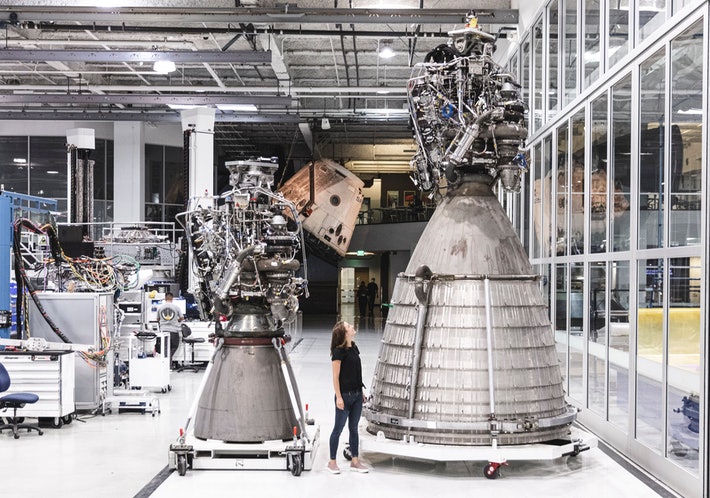raptors RSS
Elon discusses how many raptors will be need to power the Mars fleet
HOW MANY ROCKET ENGINES does it take to build a city on Mars? Somewhere around 9,000 per year, according to Elon Musk. On July 10, the SpaceX CEO outlined on Twitter how his company plans to increase production of the Raptor. The rocket engine is designed for use with the Starship, a fully-reusable stainless steel ship intended to send the first humans to Mars. In response to a question about how many Raptors SpaceX aims to produce per year, Musk tweeted: “Roughly 800 to 1000 per year. That’s about what’s needed over ten years to create the fleet to build a self-sustaining city on...
STARSHIP: SPACEX'S MARS-BOUND ROCKET IS GETTING A JAW-DROPPING UPGRADE
SpaceX's Starship is set for a powerful upgrade. Here's what you need to know. THE RAPTOR, SPACEX’S ROCKET ENGINE designed to send humans to Mars and beyond, is getting a sequel. Last week, CEO Elon Musk wrote on Twitter that the company plans to build an engine known as “Raptor 2.” This would be a more powerful version of the Raptor engine, currently being used for the under-development Starship vehicle. SPACEX STARSHIP: WHAT IS RAPTOR 2? It’s a more powerful, tweaked version of the existing Raptor engine. This engine has been used for test flights with Starship prototype models, the most recent of...
Tags
- All
- Accelerated data sharing to turn insights into actions faster
- AGI
- aging
- agriculture
- AI
- AI Models
- ai tools
- aircraft
- Alberta
- ALM pipeline automation
- ammonia
- antimatter
- Apollo 11
- Aquacities
- aquaport
- ARC -Alliance for Responsible Citizenship
- Architecture
- Arcologies
- ARK Invest
- Artificial Cognition
- autonomous ships
- autonomous trucking
- Autonomous World Development
- Azure Open AI
- Bali
- BBC News
- Bender
- Bezos
- Bias Compensation
- BIG
- Biosphere
- biosphere management
- biotechnology
- blender
- Boosted conversations
- Boston Dynamics
- business
- Canada
- Canadian Space Agency
- carbon buildings
- carbon capture
- carbon dioxide capture
- carbon neutral
- ChatGPT
- China
- Cities
- City Airbus
- cleaner
- Climate Action
- climate change
- coastal erosion
- cobots
- Cognition Enhancement
- CRISPR
- Cross-tenant dataset sharing
- cybersecurity
- DALL-E 2
- data centers
- Decentralized Energy
- Deep Space Food Challenge
- Deep Thought
- desalination
- Destiny Travel
- Digital Minds
- Digital Twins
- Digital Worlds
- Earth
- Earth Stargate Network
- electric motors
- electric vehicles
- Electricity
- Elon Musk
- Energy
- energy harvest
- energy storage
- Equality
- eVTOL
- Fairness
- floating solar
- flooding
- food
- Ford Mach-E
- fossil fuels
- FSD
- fusion
- Future of Fabrication
- Futurecrafting
- Galactic Exploration
- GasToPower
- gene therapy
- Generative AI
- generative code
- geothermal energy
- GHGs
- Gigafactory
- Github
- GPT-4
- Grace Hopper
- graphene
- greece
- green buildings
- green hydrogen
- green methane
- green mining
- green steel
- Haiti
- heatwave
- hydroelectric energy
- hydrogen
- hyperlooop
- Ignite 2022
- Indigenous
- Infuse AI into every business process
- innovation
- investment
- ion drives
- Japan
- Jennifer Heldmann
- Jordan B Peterson
- Karallen
- Kenya
- Kosmos-1
- lasers
- Lex Fridman
- Life Molecules
- Linda Yaccarino
- LNG
- longevity
- LOX
- lunar
- lunar landers
- machine learning
- Maldives
- MAPS
- mars
- medicine
- Memory Modules
- Merit
- metallic water
- metamaterials
- metaverse
- methane
- Mexico
- MFE
- MFE (Merit
- microgrids
- Microsoft AI
- Microsoft Build
- Microsoft Copilot
- Microsoft Designer
- Microsoft Dynamics 365
- Microsoft Guidance
- Microsoft Image Creator
- Microsoft Power Apps
- Microsoft Power Automate
- Microsoft Power Pages
- Microsoft Power Virtual Agents
- Microsoft Security Copilot
- Microsoft Windows
- mixed reality
- MLLM
- Mobile Farms
- mobile habitats
- modular ships
- molten salts
- Multimodal Large Language Model
- Multiversal Stories
- mushrooms
- Neil Gershenfeld
- NGEN
- NIF
- Nigeria
- non-carbon fuels
- Norway
- nuclear spacecraft
- Nvidia
- Oceanix
- oceans
- Omniverse
- OpenAI
- pandemic adaption
- particle accelerators
- Payments
- permafrost
- Peter Diamandis
- Planet Express
- Planetary Energy
- plastic waste
- pollution
- Power Automate description to cloud flow
- Power Automate format data by examples
- power ships
- powerplants
- PowerToGas
- Prime
- printed meat
- Proteins
- quantum processors
- raptors
- Ray Kurzweil
- refueling
- Relationship
- renewable energy
- renewable fuels
- research yacht
- resources
- Responsible AI
- restaurants
- RethinkX
- Rivian
- robotic food processing
- robotics
- s
- Salim Ismail
- Scale low-code securely
- sea level rise
- self -drive
- self-healing
- Self-Replicating Robots
- Share interactive Power BI charts directly from OneDrive and SharePoint
- Shimizu
- shipping container homes
- ships
- Siberia
- Singapore
- Singularitarianism
- Singularity Philosophy
- Singularity Ready
- smartphone
- solar canals
- solar desalination
- solar domes
- solar energy
- space
- Space tourism
- SpaceX
- Starbase
- StarCities
- Starflights
- Stargates
- Starlink
- Starport Network
- Starport space
- Starports
- Starshield
- starship
- submarine
- Suborbital Starflights
- Superchargers
- superconductivity
- sustainability
- taxi
- Technology
- TED
- Terracity
- Tesla
- Tesla Energy
- tiny home
- tow charging
- Toyota
- treehouse
- trucking
- UAE
- UN Habitat
- unity
- Updates to document processing with AI Builder
- urban planning
- Uzbekistan
- vertical farms
- warehousing
- waste
- WATER
- wildfire
- wind farms
- World Bank
- yacht
- zero emission ships
- Zero Emission Vehicles
- zero emissions power


